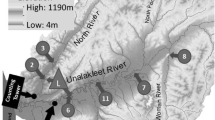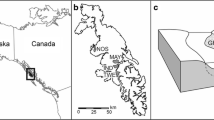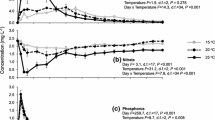Abstract
The loss of subsidies delivered by anadromous fish to inland stream ecosystems may have profound influences on stream food webs. However, studies have focused on food web responses in ecosystems where the fish assemblage is dominated by salmonids. We evaluated food web responses to carcass additions in three locations of an interior Columbia River Basin stream with varying native fish assemblages. Periphyton biomass responses were mixed with increases in treatment compared to control reaches of the middle and downstream pairs, but not in the upstream pair where scavenging by bears removed the majority of carcasses. Stable isotope analysis revealed marine-derived nutrient (MDN) enrichment of periphyton and invertebrate functional feeding groups in the middle and downstream pairs (up to 12% MDN derived), but not in the upstream pair. Non-salmonid fish exhibited limited MDN assimilation (~ 5 and 10% MDN derived), with isotopic enrichment patterns similar to lower trophic levels and little evidence of eggs and carcass material consumption, suggesting bottom-up transfer of MDN to non-salmonid fishes. In contrast, across the three study pairs, juvenile Chinook Salmon (Oncorhynchus tshawytscha) and steelhead trout (O. mykiss) assimilated MDN rapidly, obtaining up to 25% and 57% of their nitrogen from carcasses, respectively. Diet analysis and isotopic enrichment patterns indicated that juvenile salmonid assimilation occurred primarily through direct consumption of eggs and carcass tissue. Our findings suggest that salmonids in this region may experience more benefit from carcass additions containing eggs, while non-salmonids are likely to experience minimal MDN incorporation whether or not eggs are present.





Similar content being viewed by others
References
Arar EJ, Collins GB. 1997. In vitro determination of chlorophyll a and pheophytin a in marine and freshwater algae by fluorescence. Page US Environmental Protection Agency Method 445.0 Revision 1.2. Cincinnati, Ohio.
Armstrong JB, Schindler DE, Omori KL, Ruff CP, Quinn TP. 2010. Thermal heterogeneity mediates the effects of pulsed subsidies across a landscape. Ecology 91:1445–54.
Bellmore JR, Benjamin JR, Newsom M, Bountry JA, Dombroski D. 2017. Incorporating food web dynamics into ecological restoration: A modeling approach for river ecosystems. Ecol Appl 27:814–32.
Benjamin JR, Bellmore JR, Watson GA. 2016. Response of ecosystem metabolism to low densities of spawning Chinook Salmon. Freshw Sci 35:810–25.
Bentley KT, Schindler DE, Armstrong JB, Zhang R, Ruff CP, Lisi PJ. 2012. Foraging and growth responses of stream-dwelling fishes to inter-annual variation in a pulsed resource subsidy. Ecosphere 3:113.
Bilby RE, Fransen BR, Bisson PA, Walter JK. 1998. Response of juvenile coho salmon (Oncorhynchus kisutch) and steelhead (Oncorhynchus mykiss) to the addition of salmon carcasses to two streams in southwestern Washington, U.S.A. Can J Fish Aquat Sci 55:1909–18.
Bilby RE, Fransen BR, Bisson PA. 1996. Incorporation of nitrogen and carbon from spawning coho salmon into the trophic system of small streams: evidence from stable isotopes. Can J Fish Aquat Sci 53:164–73.
Brauns M, Boechat IG, de Carvalho APC, Graeber D, Gucker B, Mehner T, Von Schiller D. 2018. Consumer-resource stoichiometry as a predictor of trophic discrimination (D13C, D15N) in aquatic invertebrates. Freshw Biol 63:1–10.
Chaloner DT, Martin KM, Wipfli MS, Ostrom PH, Lamberti GA. 2002. Marine carbon and nitrogen in southeastern Alaska stream food webs: evidence from artificial and natural streams. Can J Fish Aquat Sci 59:1257–65.
CHaMP (Columbia Habitat Monitoring Program). 2016. Scientific protocol for salmonid habitat surveys within the Columbia Habitat Monitoring Program.
Claeson SM, Li JL, Compton JE, Bisson PA. 2006. Response of nutrients, biofilm, and benthic insects to salmon carcass addition. Can J Fish Aquat Sci 63:1230–41.
Collins SF, Baxter CV, Marcarelli AM, Wipfli MS. 2016. Effects of experimentally added salmon subsidies on resident fishes via direct and indirect pathways. Ecosphere 7(3):1–18.
Collins SF, Marcarelli AM, Baxter CV, Wipfli MS. 2015. A critical assessment of the ecological assumptions underpinning compensatory mitigation of salmon-derived nutrients. Environ Manag 56:571–86. Springer US.
Cummins KW, Wuycheck JC. 1971. Caloric equivalents for investigations in ecological energetics. Mitteilungen der Internationale Vereinigung fur Theoretische und Angewandte Limnologie 18:1–158.
Gresh T, Lichatowich J, Schoonmaker P. 2000. An estimation of historic and current levels of salmon production in the northeast pacific ecosystem: evidence of a nutrient deficit in the freshwater systems of the Pacific Northwest. Fisheries Habitat 25:15–21.
Gustafson RG, Waples RS, Myers JM, Weitkamp LA, Bryant GJ, Johnson OW, Hard JJ. 2007. Pacific salmon extinctions: Quantifying lost and remaining diversity. Conserv Biol 21:1009–20.
Humphries P, Winemiller KO. 2009. Historical impacts on River Fauna, shifting baselines, and challenges for restoration. Bioscience 59:673–84.
Isaak DJ, Wenger SJ, Peterson EE, Ver Hoef JM, Nagel DE, Luce CH, Hostetler SW, Dunham JB, Roper BB, Wollrab SP, Chandler GL, Horan DL, Parkes-payne S. 2017. The NorWeST summer stream temperature model and scenarios for the western U.S.: A crowd-sourced database and new geospatial tools foster a user community and predict broad climate warming of rivers and streams. Water Resour Res 53:1–25.
Janetski DJ, Chaloner DT, Tiegs SD, Lamberti GA. 2009. Pacific salmon effects on stream ecosystems: a quantitative synthesis. Oecologia 159:583–95.
Johnston NT, MacDonald JS, Hall KJ, Tschaplinski PJ. 1997. A preliminary study of the role of sockeye salmon (Oncorhynchus nerka) carcasses as carbon and nitrogen sources for benthic insects and fishes in the “Early Stuart” stock spawning streams, 1050 km from the Ocean. Fish. Project Rep. RD55, British Columbia Ministry of Environment, lands and Parks, Victoria, B.C.
Kaylor MJ, Argerich A, White SM, Verwey BJ, Arismendi I. 2018. A cautionary tale for in situ fluorometric measurement of stream chlorophyll a: influences of light and periphyton biomass. Freshw Sci 37:287–95.
Kaylor MJ, White SM, Saunders WC, Warren DR. 2019. Relating spatial patterns of stream metabolism to distributions of juvenile salmonids at the river network scale. Ecosphere 10(6):e02781.
Kaylor MJ, White SM, Sedell ER, Warren DR. 2020. Carcass additions increase juvenile salmonid growth, condition, and size in an interior Columbia River Basin tributary. Can J Fish Aquat Sci 77(4):703–15.
Kiernan JD, Harvey BN, Johnson ML. 2010. Direct versus indirect pathways of salmon-derived nutrient incorporation in experimental lotic food webs. Can J Fish Aquat Sci 67:1909–24.
Kiffney PM, Naman SM, Cram JM, Liermann M, Burrows DG. 2018. Multiple pathways of C and N incorporation by consumers across an experimental gradient of salmon carcasses. Ecosphere 9:e02197.
Kohler AE, Pearsons TN, Zendt JS, Mesa MG, Johnson CL, Connolly PJ. 2012. Nutrient enrichment with salmon carcass analogs in the Columbia River Basin, USA: A stream food web analysis. Trans Am Fish Soc 141:802–24.
Marczak LB, Thompson RM, Richardson JS. 2007. Meta-analysis: Trophic level, habitat, and productivity shape the food web effects of resource subsidies. Ecology 88:140–148.
Meehan WR, Miller RA. 1978. Stomach flushing: effectiveness and influence on survival and condition of Juvenile Salmonids. J Fish Res Board Canada 35:1359–63.
Merritt RW, Cummins KW, Berg MB, editors. 2008. An introduction to the aquatic insects of North America. Kendell Hunt Publishing Company.
Momot WT, Jones PD. 1978. The dynamics of crayfish and their role in ecosystems. Am Midland Naturalist 99:10–35.
Moore JW, Schindler DE. 2008. Biotic disturbance and benthic community dynamics in salmon-bearing streams. J Anim Ecol 77:275–84.
Morley SA, Coe HJ, Duda JJ, Dunphy LS, Mchenry ML, Beckman BR, Elofson M, Sampson EM, Ward L. 2016. Seasonal variation exceeds effects of salmon carcass additions on benthic food webs in the Elwha River. Ecosphere 7:e01422.
Naiman RJ, Bilby RE, Schindler DE, Helfield JM. 2002. Pacific salmon, nutrients, and the dynamics of freshwater and riparian ecosystems. Ecosystems 5:399–417.
Nehlsen W, Williams JE, Lichatowich JA. 1991. Pacific Salmon at the Crossroads: Stocks at Risk from California, Oregon, Idaho, and Washington. Fisheries 16:4–21.
ODFW (Oregon Department of Fish and Wildlife). 1990. Grande Ronde River Subbasin Salmon and Steelhead Production Plan. Portland, OR
Parnell AC, Phillips DL, Bearhop S, Brice X, Ward EJ, Moore JW, Jackson AL, Grey J, Kelly DJ, Inger R. 2013. Bayesian stable isotope mixing models. Environmetrics 24:387–99.
Phillips DL, Inger R, Bearhop S, Jackson AL, Moore JW, Parnell AC, Semmens BX, Ward EJ. 2014. Best practices for use of stable isotope mixing models in food-web studies. Can J Zool 92:823–35.
Polis GA, Anderson WB, Holt RD. 1997. Toward the integration of landscape and food web ecology: the dynamics of spatially subsidized food webs. Annu Rev Ecol Syst 28:289–316.
Post DM. 2002. Using stable isotopes to estimate trophic position: Models, methods, and assumptions. Ecology 83:703–18.
Rahel FJ, Hubert WA. 1991. Fish assemblages and habitat gradients in a Rocky Mountain-great plains stream: biotic zonation and additive patterns of community change. Trans Am Fish Soc 120:319–32.
Ruegg J, Chaloner DT, Ballantyne F, Levi PS, Song C, Tank JL, Tiegs SD, Lamberti GA. 2020. Understanding the relative roles of salmon spawner enrichment and disturbance: A high-frequency, multi-habitat field and modeling approach. Front Ecol Evol 8:1–14.
Ruzycki JR, Flesher MW, Carmichael RW, Eddy DL. 2003. Lower snake river compensation plan: Oregon evaluation studies-steelhead life history, genetics, and kelt reconditioning. La Grande, OR: Oregon Department of Fish and Wildlife.
Sanderson BL, Tran CD, Coe HJ, Pelekis V, Steel EA, Reichert WL. 2009. Nonlethal sampling of fish caudal fins yields valuable stable isotope data for threatened and endangered fishes. Trans Am Fish Soc 138:1166–77.
Schindler DE, Scheuerell MD, Moore JW, Gende SM, Francis TB, Palen WJ. 2003. Pacific salmon and the ecology of coastal ecosystems. Front Ecol Environ 1:31–7.
Swain NR, Hocking MD, Harding JN, Reynolds JD. 2014. Effects of salmon on the diet and condition of stream-resident sculpins. Can J Fish Aquat Sci 71:521–32.
Tiegs SD, Campbell EY, Levi PS, Ruegg J, Benbow ME, Chaloner DT, Merritt RW, Tank JL, Lamberti GA. 2009. Separating physical disturbance and nutrient enrichment caused by Pacific salmon in stream ecosystems. Freshw Biol 54:1864–75.
Torgersen CE, Baxter CV, Li HW, McIntosh BA. 2006. Landscape influences on longitudinal patterns of river fishes: spatially continuous analysis of fish – habitat relationships. Am Fish Soc Symp 48:473–92.
Wallace JB, Eggert SL, Meyer JL, Webster JR. 1999. Effects of resource limitation on a detrital-based ecosystem. Ecol Monog 69:409–442.
Warren DR, Harvey CJ, McClure MM, Sanderson BL. 2014. Use of an ecosystem-based model to evaluate alternative conservation strategies for juvenile Chinook Salmon in a headwater stream. N Am J Fish Manage 34:839–852.
White SM, Giannico G, Li H. 2014. A ‘behaviorscape’ perspective on stream fish ecology and conservation: linking fish behavior to riverscapes. WIRE Water 1:385–400.
Winder M, Schindler DE, Moore JW, Johnson SP, Palen WJ. 2005. Do bears facilitate transfer of salmon resources to aquatic macroinvertebrates? Can J Fish Aquat Sci 62:2285–93.
Wipfli MS, Baxter CV. 2010. Linking ecosystems, food webs, and fish production: subsidies in salmonid watersheds. Fisheries 35:373–87.
Wipfli MS, Hudson J, Caouette J. 1998. Influence of salmon carcasses on stream productivity: response of biofilm and benthic macroinvertebrates in southeastern Alaska, U.S.A. Can J Fish Aquat Sci 55:1503–11.
Wipfli MS, Hudson JP, Chaloner DT, Caouette JP. 1999. Influence of salmon spawner densities on stream productivity in Southeast Alaska. Can J Fish Aquat Sci 56:1600–11.
Acknowledgements
We thank C. Hayes, J. Dowdy, the ODFW Early Life History crew, and the Bureau of Reclamation summer interns for their assistance in field work. J. Dowdy, A. Dutterer, S. Favrot, W. Morton, A. Simpson, and staff of the Grande Ronde Model Watershed provided logistical assistance. B. Bilby, A. Kohler, and S. Collins provided feedback on initial experimental design. S. Johnson, W. Gerth, and I. Arismendi provided laboratory space and assistance. Ruth Bowman provided access to sites located on private property. This research was supported by the Bonneville Power Administration as part of the Columbia Basin Fish Accords Agreement (Project # 2009-004-00), an Oregon Watershed Enhancement Board (OWEB) Focused Investment Partnership (Project # 216-8205-15449), and a National Science Foundation Graduate Research Fellowship (Grant No. 1314109-DGE). The data that support the findings of this study are available from the corresponding author upon reasonable request.
Author information
Authors and Affiliations
Corresponding author
Additional information
Author’s Contribution
MJK contributed to the study design, conducted research, analyzed data, and wrote the manuscript. SMW and DRW contributed to the study design, conducted research, and wrote the manuscript. ERS contributed to the study design and conducted research. AMS conducted research and wrote the manuscript.
Electronic supplementary material
Below is the link to the electronic supplementary material.
Rights and permissions
About this article
Cite this article
Kaylor, M.J., White, S.M., Sedell, E.R. et al. Carcass Additions Influence Food Webs Through Bottom-Up and Direct Consumption Pathways Along a Fish Species Assemblage Gradient. Ecosystems 24, 168–184 (2021). https://doi.org/10.1007/s10021-020-00510-x
Received:
Accepted:
Published:
Issue Date:
DOI: https://doi.org/10.1007/s10021-020-00510-x




